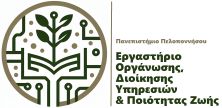Adoption and Diffusion of Digital Applications in Universities: Need or Redundancy?
- Λεπτομέρειες
- Κατηγορία: Εξ Αποστάσεως Σεμινάρια
1. Enhanced Interconnectedness and Communication:
Utilization of online communication and collaboration tools, such as Slack, Microsoft Teams, and Zoom, facilitates seamless interaction among students, faculty, and researchers across geographical boundaries. These digital tools enable universities to transcend physical limitations and engage in collaborative efforts with external entities, including academic institutions, industry partners, and research organizations. This heightened collaboration fosters the exchange of knowledge and ideas, thereby promoting a culture of innovation.
2. Globalization and Diversity of the Student Body:
The adoption of online learning platforms and digital marketing strategies enables universities to attract a diverse student population from diverse geographic locations through platforms like Massive Open Online Courses (MOOCs). A diverse student body brings together a multiplicity of perspectives and experiences, thereby stimulating an environment conducive to innovation. Exposure to varying viewpoints encourages critical thinking and innovative problem-solving.
3. Data-Driven Decision-Making:
Universities amass substantial datasets concerning student performance, research outcomes, and institutional operations. Analytical tools like Tableau and Power BI are employed to derive insights from this data. The embrace of data-driven decision-making empowers universities to discern patterns, strengths, and weaknesses. By optimizing their operations and educational
offerings based on data-driven insights, universities can enhance their innovative capabilities and competitive edge.
4. Virtualized Laboratories and Simulations:
Digital applications facilitate the creation of virtual laboratories and simulations that emulate real-world scientific experiments, rendering them accessible to students and researchers. Virtualized laboratories and simulations expand research horizons while minimizing the costs associated with physical infrastructure. This advancement fosters innovation by affording students and researchers the opportunity to conduct experiments that may be impractical or prohibitively expensive in a traditional setting.
5. Online Innovation Hubs and Incubators:
Universities can establish online innovation hubs and startup incubators, which serve as platforms for collaborative entrepreneurial endeavors among students and faculty. These digital platforms provide fertile ground for the development of innovative ideas and the cultivation of entrepreneurial skills. By connecting students and researchers with mentors, investors, and industry experts, universities can foster an environment that nurtures innovation and entrepreneurship.
6. Access to Extensive Research Resources:
Digital libraries, academic databases, and online research repositories grant easy access to a wealth of academic literature and scholarly resources. This unfettered access to information expedites research and innovation by keeping students and faculty abreast of the latest developments in their respective fields, thereby instilling a culture of continual learning and innovation.
7. Online Competitions and Innovation Challenges:
Universities can host and participate in online hackathons and innovation competitions, prompting students to devise creative solutions to real-world problems. Such events serve as catalysts for innovation by encouraging students to think innovatively, work collaboratively across disciplinary boundaries, and apply their knowledge to practical scenarios.
Concluding, the adoption and integration of digital applications in academic institutions will have a profound and far-reaching impact on their future. These changes will affect various aspects of academia, shaping the landscape of tomorrow in a significant way.



